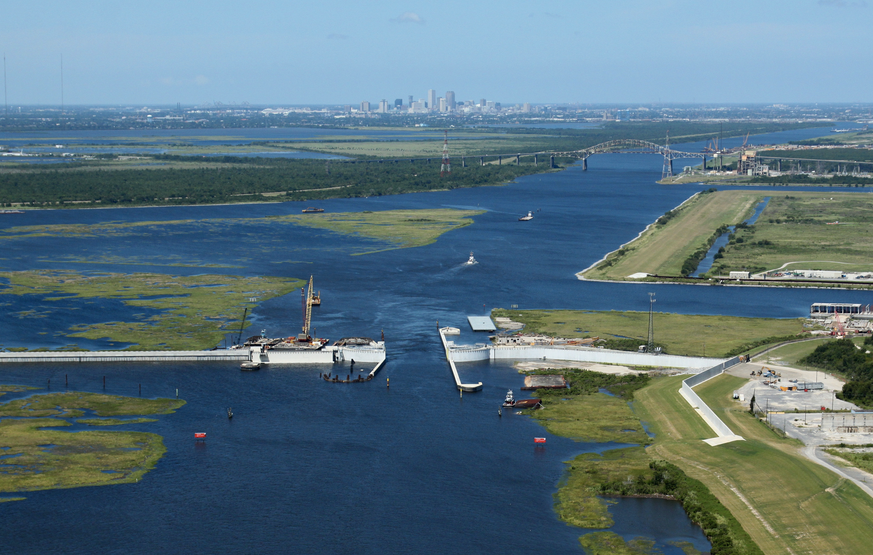
They’re getting closer, but this ain’t horseshoes.
That was the verdict by the local flood protection authority this week after the U.S. Army Corps of Engineers completed the first-ever open-close-open circuit of the now-infamous barge gate on the Lake Borgne Storm Surge Barrier at the Intracoastal Waterway.
Parts failures didn’t stop the procedure as has happened in all previous tries since the structure was installed more than a year ago. But an oil leak spotted during the cycle forced postponement of further testing and cost the gate a passing grade from the Southeast Louisiana Flood Protection Authority-East.
“It was certainly opened and closed for the first time,” said Bob Turner, regional director of the flood authority. “But it wasn’t without issues, because of the oil leak.
“So we would consider a totally successful opening and closing when we’re able to do it without problems.
And that’s what we’re all working toward.”
Chris Gilmore, the corps’ senior project manager, said in an email exchange that the oil was determined to be leaking from “the sight glass on the closing windlass brake system.”
He said the contractor, Shaw Group of Baton Rouge, expected to have the problem fixed by the end of this week.
The gate was a major source of concern for the flood authority — and a point of dispute with the corps — even before it was installed prior to last year’s hurricane season.
The opening it blocks was designed as a by-pass channel to be used only when the gate guarding the main shipping channel is closed for routine maintenance, expected every 10 to 15 years. In other words, the gate would be closed for most of its life.
The design chosen for the main opening was a “sector gate,” a well-proven structure with two wide arms that can swing shut in about 90 minutes. It is common on waterways around the world.
But for the by-pass channel Shaw chose the seldom-used and very complicated barge-gate design. Its name comes from a huge concrete barge 190-feet long, 70-feet wide and 44-feet deep that must be swung into the gap in the surge barrier then filled with water and sunk to prevent storm surge from pouring through.
It takes 9.5 hours to close, when working properly.
The corps said the barge gate was chosen because it was less expensive and could be installed faster than a second sector gate.
It has had problems from the start.
The channel currents turned out to be too strong for safe ship operation when the secondary channel was closed so the corps decided it would leave the barge gate open except when a storm was approaching.
But the currents at most times are also too strong for the motors in the barge gate, a problem the corps was working to fix.
Then came the breakdowns as the corps put the barge gate through its paces. The first try ended in failure when the barge was punctured by a piece of iron refuse resting on the bottom of the waterway. Subsequent attempts were aborted due to parts failures.
The corps said the breakdowns were merely routine kinks found in all new systems, but it has taken nearly a year to come close to working them out.
The flood authority remains unhappy with the design. Leaving the gate open means having a hole in the city’s eastern defenses that must be closed with a structure it can’t count on.
To guard against problems already identified, the agency has gone to the expense of hiring a diving contractor to make sure the bottom of the waterway is debris-free. In addition, a tug boat stands by to provide brute force for a closure if the system breaks down.
The misjudged current tolerances have led the corps to declare that the structure should be closed 96-hours – four days – before a storm is expected to make landfall in the area.
“Basically, we’ll be closing this thing any time a tropical disturbance or even a low-pressure system is in the Gulf,” Turner said. “We’re not leaving anything to chance because the risk to the community we’re protecting is simply too great.
“We’re going to keep working with the corps to get this all squared away before hurricane season” — which begins June 1.
The corps is scheduled to hand over operation and maintenance of the entire Hurricane and Storm Damage Risk Reduction System by that date, but the receiving agency, the state Coastal Protection and Restoration Authority, is seeking congressional authorization to require that the corps retain responsibility for the barge gate and adjacent sector gate, which would otherwise be operated by the flood authority.

